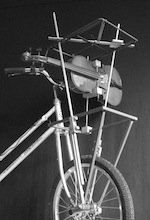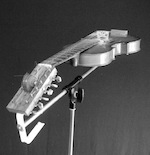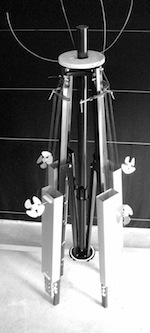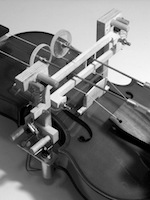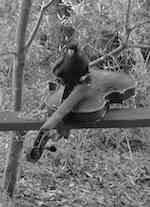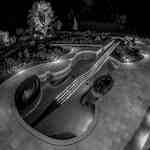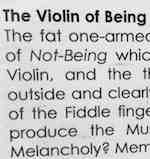 | |||||||

|
Rosenberg Museum 2014 new instruments new activities |
|||
|
NEW INSTRUMENTS The Rosenberg Museum is proud to present 4 new instruments made in 2014 The Rhythm Machine is a further development from concepts realised in The Pursuit Project The thing about bicycle powered music is that, unlike an electronic loop, the sonic events are never repeated exactly due to material restraints, qualities, and inaccuracies; plus there is the real-time experience of sound being transformed in a unique space - which is not equivalent to the sensation of electronically processed surround sound. The Rhythm Machine is equipped with a modified break. Instead of being applied to its logical function (I agree that can be useful in certain circumstances!), the breaking mechanism controls the amount of space (defined by a metal frame) within which the double bow mechanism, being generated by the front wheel, can be restrained and thus the rhythms interfered with. Using the break can cause some interesting shifts and phasing between the basic perceived time values of 2/4 and 3/4. Other sounds such as clonks, rasps, sqeals, buzzes, add to the general character of sonic "unsafeness", coming and going at will (their will). The 12 String Viola also known as The Cluster Fuck. In recent years I've been missing a number of instruments that I built in the 1970s which were designed to fulfill a specific musical function, the 16 string long neck violin was one such invention which I wished to re-visit. The Cluster Fuck takes up where the long neck violin finished (now a wreck and awaiting restoration in The Rosenberg Museum, ). Modifications to a regular cheap Chinese viola include: a hacked scroll being replaced with a block and machine heads for a 12 string guitar; three variable bridges enabling, for example, the course of 12 strings to be played in three distinct bowing angles - 4 strings to each stroke, or for some strings to be removed from the playing arc and act as sympathetic strings only; a fretted fingerboard is fitted to achieve an impossible non-equal tempered scale the exact pitch measurements of which have yet to be rationalised (if indeed they can be); the tail piece has been removed to provide extra resonance; the instrument can be played laterally or virtually in any position except under the chin (which is extremely uncomfortable). The Portable Monochord consists of a collapsible double resonator instrument; no traveling string player should be without one of these. Despite being 127 Centimeters long when fully extended, this instrument will fit in a standard air travel case when closed. Performed music remains still a practical problem to solve. The monochord has already provided many a happy moment as an arsenal of avant garde string techniques, and functions very well as an accompaniment to my partner's (Hollis Taylor) renditions of fiddle tunes at top tempi. Hills Hoist Music (formally known as "Violin Weather") is is in fact structurally speaking just that - a Hills Hoist which has been sonified. There are 3 basic methods of sound production. 1. Through the use of propellers that have a thin gauge wire "whisker" attached to their central hubs; the whisker strokes (rather than plucks) the strings at speeds controlled by the wind. Changes of wind direction excite varying combinations of the 4 resonators at different speeds; propellers and bridges can be aligned and fixed in position, so that all 4 propellers can be engaged at one time if the wind is steady in one direction - and if the operator desires that particular sonic result. But in general, most sonically appealing is the give and take, starts and stops, between the resonators and strings as the Hills Hoist moves to the changes in wind. 2. When the wires of both the resonators and the replaced "clothes lines" line up against the general flow of the wind, classic Aeolian effects can be encouraged (these resonances are always present to a degree). Because of the time it takes for an Aeolian effect to "excite" a string, the hoist can be lowered to fit into lock position, thereby limiting the angles at which the wind can engage, providing a more efficient interface for the excitation to work through the harmonic series of the strings. 3. In the case of a visit to the Hills Hoist Music on a day in which the wind has absented itself from concert attendance, a fixed central plectrum mechanism has been installed, thus enabling visitor to move the arms of the Hill Hoist around and get an impression of the potential resonance locked up inside the Hills Hoist on a windy day. Further experiments are in progress to effect a more dynamic "whirling" Hills Hoist including the use of wind blades or moveable rudders on the end of each of the arms. The problem with this is that the faster the arms make the structure rotate, the less chance the propellers have of "getting up speed" before the wind angle changes. Keeping the modifications appropriate too, and within the original design of the Hills Hoist, determines a wide operational set of possibilities and sonic variety. The Hills Hoist was a smart piece of Australian design - from the days when we did that kind of thing. Hoist that Hills video here. The Data Violin is a joint project between Martin Riches, Sukanda Kartadinata, and Jon Rose. This international collaboration between Martin (who invents machines that physically "talk" amongst other wonders of science, creativity, and perseverance), Sukanda (who is one of the most in demand creative software engineers in Berlin, a fine musician, and a problem solver par excellence) and myself, comes together to realise a fantasy that has been sitting in one of my sketch books for over 10 years. In a world when, via digital technology, anything can be transformed into anything else or yet more versions of itself, I considered what could be the ugliest thing on the planet and how could it be manifest as something beautiful - its antithesis. Logically enough current money generating data from Wall Street must be (outside the military use of technology) the most redolent paradigm of shit that can be imagined - "let's make violin music from it" I thought. And so it came to pass (the idea that is, not the shit). The Data Violin (violin music powered directly by real time data from Wall Street) will make its world premiere at The Rosenberg Museum in Berlin, May, 2015. RECENT ACTIVITIES The twisted trilogy of Rosenberg books is finally completed with rosenberg 3.0; although not exactly flying off the shelves of your local bookshop (if indeed you have one), it was launched 23/11/2014 at The People's Republic, Sydney on one of the hotest days in November ever recorded. Sound and images from The Rosenberg Museum were featured in two exhibitons at the end of 2014. As part of Sound Art Exhibition On The Edge of Perceptibility 18 October-23 November, at The Mucsarnok Kunsthalle, Budapest, Hungary. Interwiew with Jozef Cseres, director of The Rosenberg Museum here in The Kunsthalle, Budapest. As part of The Rosenberg Installation Audio Art Festival 12-20 December, Krakow, Poland.
|
 |
